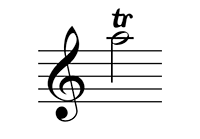Quiz #19 - Ornaments
Ornaments flashcards
Quiz #19 - Ornaments
Test your knowledge on ornaments with this tutorial.
After you have watched the video above, you can either enter the number of your correct answers below to see how you did compared to other users, or you can proceed with the review and the practice test below.
How many correct answers did you get?
Quiz Review
Music Ornaments
Music Ornaments (also known as "embellishments" or "flourishes") are decorative notes added to a musical phrase to enhance its expressiveness and complexity. They are typically not essential to the main melody but serve to add character, nuance, and style to the music. Ornaments are common in Baroque, Classical, and Romantic music, but they also appear in modern compositions and improvisation.
Here are the most common music ornaments:
|
Trill A trill is a rapid alternation between two notes. |

|
|
Mordent A mordent is a quick upward and downward movement between two notes. |

|
|
Inverted Mordent An inverted mordent is a quick downward and upward movement between two notes. |

|
|
Turn A turn is a musical ornament consisting of a rapid sequence of four notes that embellish a main note. |

|
|
Inverted Turn Similar to the regular turn, the order of the notes is inverted. |

|
|
Acciaccatura An acciaccatura is a type of musical ornament known as a grace note, played as a very quick, crushed note just before the main note. |

|
|
Appoggiatura An appoggiatura is a type of musical ornament that consists of a grace note that leans on the main note taking time from it. |

|
|
Double Acciaccatura A double acciaccatura a rapid succession of two or more acciaccaturas. |

|
|
Double Appoggiatura A double appoggiatura is a succession of two or more appoggiaturas. |

|
|
Arpeggiato An arpeggiato is a type of musical ornament in which the notes of a chord are played in rapid succession rather than simultaneously. |

|
|
Glissando A glissando is a musical ornament that consists of a rapid slide between two pitches, passing through all the intermediate notes in a smooth, continuous motion. |

|
Learn more about ornaments in the Music Ornaments part of the Basic Music Principles theory section.
Practice test
Here are your previous test results dated July 27, 2025
Wrong: 1
(10 of 10)
Correct: 9
What ornament is this?

What Next? Post Your Comments or Questions!
Learn music with our AI Music Assistant: Try it now!
Comments or Questions
Do you like the content of this page?
Music Experts Video Lessons
Video Lessons from Music Experts
Improve your piano playing with our video lessons. Presented by top-notch music teachers, our structured video lessons, you'll gain the skills and confidence needed to play with precision and artistry.
My Account
About Virtual Sheet Music
Explore
Copyright ©1999-2025 Virtual Sheet Music, Inc. - All Rights Reserved
